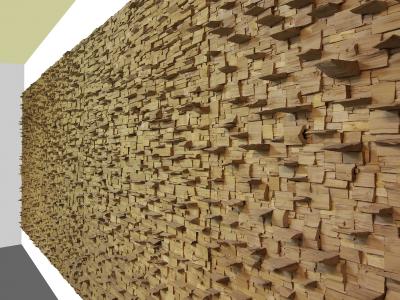Jan de Weryha-Wysoczański
Mediathek Sorted






































































































Connections have even been made between de Weryha's works and Action Art and happenings in the 1970s.[16] In 1968 the Polish sculptor Jerzy Bereś began performing as an action artist, using his ethnographically inspired wooden assemblages and Dadaistic-looking vehicles in ritual happenings and performances, and adapting finds from nature in artistic actions that protested against the destruction of the natural world. Decades later, these found objects could still be seen as individual objects in exhibitions. Tadeusz Kantor had been working in the theatre since 1961 with "poor" and "scanty" props as the carriers of true-to-life objectivity. What remained of his stage performances and happenings were assemblages like his group of works "Emballages"; and objects from Edward Krasiński's Happenings that appeared constructivist, were charged with meanings and intended to "release energies". These objects also later found their way into exhibitions, collections, and museums, as did numerous objects by Joseph Beuys, which were removed after his actions and thus became autonomous works of art. Although De Weryha has not organised any actions, happenings or performances as the results of ongoing artistic processes, his elaborately placed and detailed ground works have an impact, not least due to the rough character of the material and the use of finds from nature.
Wojciechowski was probably the first to point out that de Weryha arranged the wood in some of his wall objects like books, thus creating "powerful, mysterious libraries" (ill. 32, 35, 45, 46).[17] In the same year an exhibition which presented ground works and free-standing objects in the Patio Art Gallery/Patio Galeria Sztuki in Łódź, was also entitled Drewno-archiwum (English: Wood Archive), an exhibition in 2009 in the Municipal Gallery in Gdansk/Gdańska Galeria Miejska was entitled “Tabularium”, a term that in Roman times referred to rooms and buildings used for storing documents and archival records. As Urszula Usakowska-Wolff wrote in the catalogue of the exhibition in Łódź, on closer inspection some of the "Wooden Panels" resembled 18th century wooden libraries, xylotheques. Other works, which consisted of thousands of pieces of wood, perhaps centuries old, were a "unique archive of timeless time".[18] Grażyna Tomaszewska-Sobko wrote about de Weryha's exhibition in Gdansk that de Weryha's work was "an attempt to archive material coming from the world of nature". Katarzyna Rogacka-Michels remarked that "he creates the impression of a morphology of wood or of a wood archive".[19]
These connotations to the work of de Weryha also have a counterpart in 20th century art. In the aftermath of Post Minimal Art and Arte Povera, in the 1970s artists began to collect traces and relics of private and social expressions of life. Nikolaus Lang collected found objects belonging to people who had died; Christian Boltanski collected remnants from his childhood; and Raffael Rheinsberg collected legacies from industrial work processes. Such activities resulted in "archives" and "inventories" in the form of ground works, in cupboards and shelves. Boltanski even created fictitious archives from inscribed empty metal boxes representing people's fates and intended to preserve their memory. That said, De Weryha has neither systematically collected wood nor presented the materials he used didactically or in rows. His artistic preoccupations focus on exploring the origins of the material, "grasping its structure and core". By means of simple interventions, he tries to influence it in such a way that it retains its identity and, as he himself says, celebrates the "Archaic in wood".[20] Decades of work have resulted in something like an "archive" (more like a museum collection of his works), which then logically provides information about the material's manifestations and the artist's working steps.
Looking back on the past two decades of his work one can see that not only the concept of the "archive", but also the aforementioned connections of his works to preceding modernist art styles are only temporarily suitable as a model for interpreting his works. De Weryha uses the multi-branched Polish, German, and international strands of Modernism to extract those tendencies that enable him to present the material he uses, wood, in an object-like manner. This enables him to add new artistic impulses to these styles and movements, some of which are historical and others still living, and use them in his preferred material.
[16] Maryla Popowicz-Bereś, master's thesis 2014, page 53 (see further reading; available online on the website of the artist, german translation, page 48)
[17] Jan Stanisław Wojciechowski 2005, p. 5/9 (see further reading; text available online on the website of the artist, polish, page 2/english, page 2)
[18] Urszula Usakowska-Wolff 2005, last paragraph (see further reading; catalog available in polish/english on the website of the artist)
[19] exhibition catalog Tabularium 2009, page 7, 11/13 (see further reading; text of Grażyna Tomaszewska-Sobko available on the website of the artist, polish, german; text of Katarzyna Rogacka-Michels ibid, polish, german, page 5)
[20] De Weryha in an online-interview with Helga König, 2015, http://interviews-mit-autoren.blogspot.de/2015/03/helga-konig-im-gesprach-mit-dem.html





















































































